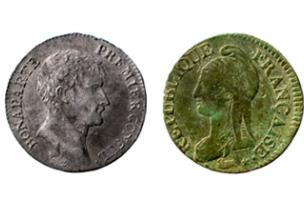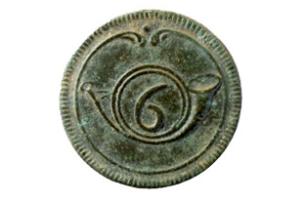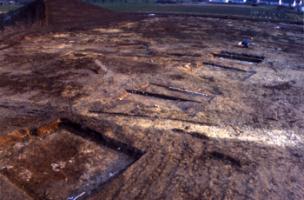You are here
Discovery of a Napoleonic army camp in Etaples-sur-Mer
A team from the Institut national de recherches archéologiques préventives (Inrap), has recently excavated part of a Napoleonic army camp at Puits d'Amour, in Etaples (Pas-de-Calais) prior to the construction of a housing estate by Pas-de-Calais Habitat.
Curated by the Regional Archaeology Service (DRAC, Nord-Pas-de-Calais), this is the first excavation of army barracks dating from the Napoleonic wars, in this case the camp of the 6th regiment of Light Infantry of the Grande Armée, stationed there from October 1803 to August 1805. The excavators have been able to correlate their findings with archival sources thus throwing new light on the organization of the camp.
A semi-permanent camp
The profusion of everyday objects strewn over the ground aids the recognition of the different areas of activity in the huts. Traces of footprints indicate passages between the sleeping areas. Potsherds found near fires show that meals were prepared and served nearby. Most of the huts had a principal and a secondary hearth. Remains of numerous clay pipes found on the ground of one of the huts indicate that it was perhaps the officers' mess. This quarter is also identified by the presence of gilt buttons found in six of the huts.
Most of the buttons are marked with a "6" inscribed in a hunting horn, that of the 6th Light Infantry Regiment. Cast in copper and set on bone, wood or copper, they illustrate different manufacturing techniques, some of which were hitherto unknown. The presence of several uniform buttons marked with the "75" of the 75th regiment of the line, not present at Etaples, as well as others apparently stamped with the star of the Order of the Garter, worn by some British regiments, remains unexplained.
Knapsack and pouch buckles, illustrating their equipment, were also found, as well as copper tokens and royal, revolutionary and consular coins.
The Etaples camp in Napoleon's military plan.
Napoleon deployed 175,000 men along the Channel and North Sea coast, from Etaples to Ostende (Belgium) for a possible crossing. But the supremacy of the Royal Navy reduced his strategy to nothing. Five weeks before the battle of Trafalgar, on September 3, 1805, he broke camp along the coasts to divert his troops towards continental military campaigns (Ulm, Austerlitz . . .).
Mahaut Tyrrell
Media communication
Inrap, media partnerships and relations
+33 6 07 40 59 77
mahaut.tyrrell [at] inrap.fr




